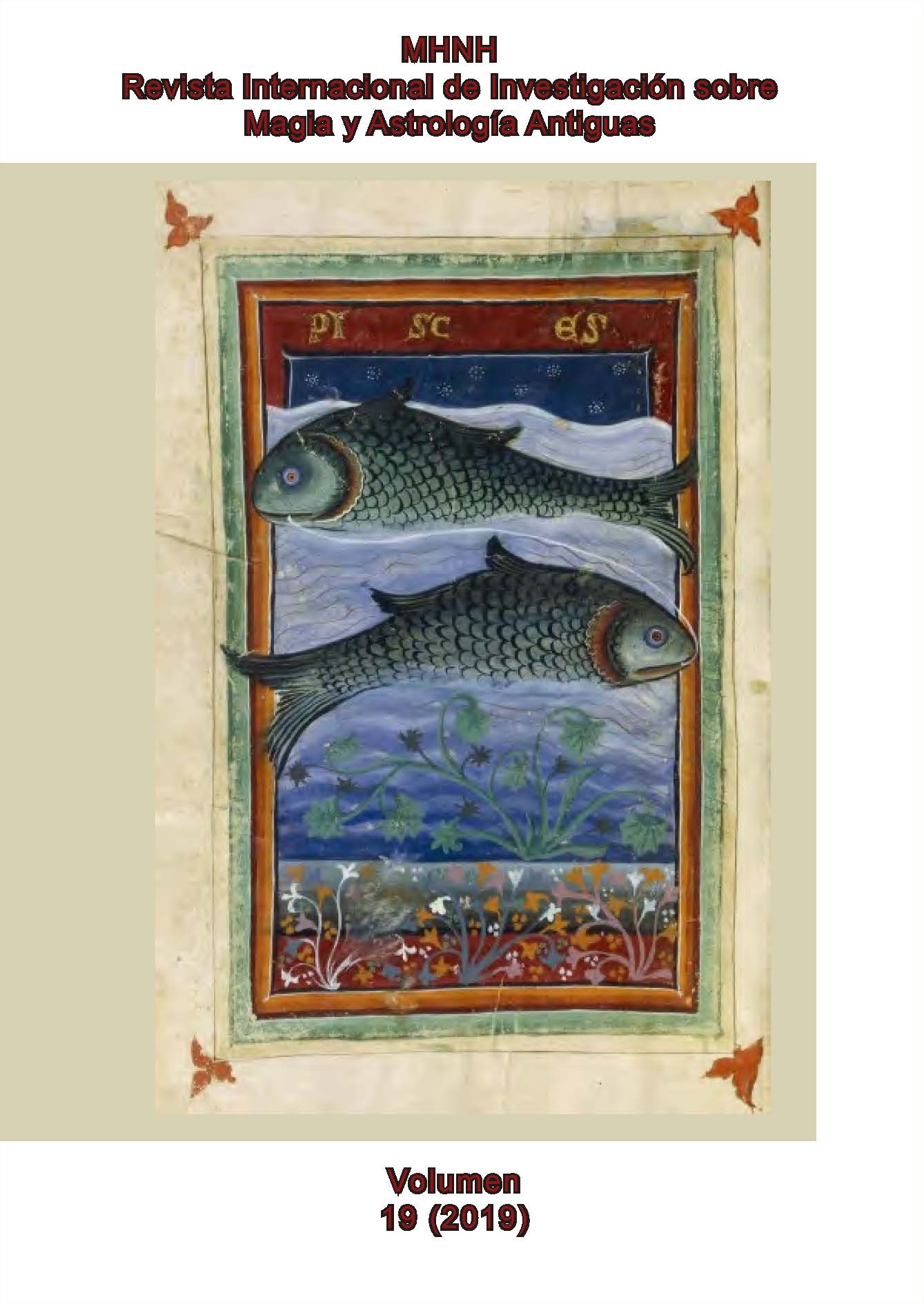Reflejado en el cielo, Segunda Parte: (a) Evidencia de Ovidio a propósito de un motivo, compartido por Roma y Jerusalén, sobre los rasgos materiales de la Metrópolis del Pueblo Elegido reflejada en una constelación celeste; (b) la creencia de que las manc
DOI:
https://doi.org/10.24310/mhnh.vi19.15411Palabras clave:
Constelaciones, Pléyades, Casiopea, Ciudad Eterna, Jerusalén, Roma, Tauro, Maya, Bona Dea, Ovidio, Arato, De facie, Araunah, Hígados AdivinatoriosResumen
Esta es la segunda parte de un estudio en cuya primera parte hemos considerado cómo Isaiah 49:16 (que los muros de Jerusalén están grabados como si estuvieran en las palmas de las manos de Dios, en el sentido de que siempre es recordada por Él) fue interpretado (como muestra Wiesenberg) por la exégesis medieval, y discutiblemente también por Isaías, en relación con la forma en W de la constelación de Casiopea (cf. al-Kaff ‘la palma de la mano’ in árabe). Es la
misma figura de la letra inicial proto-hebrea de Shalem, nombre antiguo de Jerusalén. Aquí, en la Parte Segunda, tenemos en cuenta un paralelo de la antigua Roma, en esta ocasión a propósito de otra constelación, las Pléyades. La fecha tradicional, el 21 de abril, de la fundación de Roma, corresponde a la ascensión del signo zodiacal Tauro, y la aparición de las Pléyades (siete como las Siete Colinas canónicas de Roma, aunque estas no fueron las mismas que las colinas de Roma en sus comienzos más antiguos). Los muros de Servio fueron probablemente diseñados para rodear siete colinas que correspondían a las Pléyades. Maya en particular fue la misma que la diosa romana Bona Dea, su ser idéntico fue un secreto bien guardado. Maia era el nombre secreto de Roma. Ovidio, como han defendido Vinci y Maiuri, fue castigado con el exilio mientras estaba ocupado en escribir el libro VI de los Fastos, porque en el libro V (sobre el mes de mayo) rompió un tabú, y mencionó las Pléyades y especialmente a Maya en conexión con la fundación de Roma. Esta visión permite entender mejor el episodio de travestismo de Publio Clodio Pulcher en una ceremonia solo para mujeres, que llevó al pontifex maximus, Julio César, a repudiar a su esposa
Pompea. Proponemos que aquí hubo en la antigüedad un motivo por el que un pueblo consideraría que su metrópolis (su orografía en el caso de Roma, los muros de la ciudad en el de Jerusalén) se reflejaba en el cielo en una constelación. Esto era reconfortante, en cuanto que la ciudad eterna duraría tanto como el firmamento. El motivo de una ciudad con siete colinas fue aplicado también a otras ciudades, incluyendo Constantinopla y Jerusalén. Analizamos cómo la obra homilética rabina Pirqe de-Rabbi Eliezer, cuando describe la estancia de Jonás bajo las aguas, refiere que Jerusalén está sobre siete colinas. Un hígado de bronce romano tiene en él un mapa del cielo. Elementos de la tierra se creía que estaban reflejados en el cielo en la hipótesis del espejo lunar: las manchas de la luna creían algunos (Plutarco lo atribuía a Clearco) que eran reflejos de países de la tierra, y, como Philip Stooke ha mostrado convincentemente, esto influyó la cartografía en el mundo islámico: la punta sur de África se dibujaba con un contorno bifurcado debido a un rasgo de las manchas de la cara de la luna.
Descargas
Métricas

Descargas
Publicado
Cómo citar
Número
Sección
Licencia

Esta obra está bajo licencia internacional Creative Commons Reconocimiento-NoComercial-SinObrasDerivadas 4.0.
Todos los contenidos publicados en MHNH. Revista Internacional de Investigación sobre Magia y Astrología Antiguas están sujetos a la licencia Creative Commons Reconocimento-NoComercia-Compartirigual 4.0 cuyo texto completo puede consultar en <http://creativecommons.org/licenses/by-nc-sa/4.0>
Se pueden copiar, usar, difundir, transmitir y exponer públicamente, siempre que:
- Se cite la autoría y la fuente original de su publicación (revista, editorial y URL de la obra).
- No se usen para fines comerciales.
- Se mencione la existencia y especificaciones de esta licencia de uso.
Los derechos de autor son de dos clases: morales y patrimoniales. Los derechos morales son prerrogativas perpetuas, irrenunciables, intransferibles, inalienables, inembargables e imprescriptibles. De acuerdo con la legislación de derechos de autor, MHNH. Revista Internacional de Investigación sobre Magia y Astrología Antiguas reconoce y respeta el derecho moral de los autores/as, así como la titularidad del derecho patrimonial, el cual será cedido a la Universidad de Málaga para su difusión en acceso abierto. Los derechos patrimoniales, se refieren a los beneficios que se obtienen por el uso o divulgación de las obras.MHNH. Revista Internacional de Investigación sobre Magia y Astrología Antiguas se publica en open access y queda autorizada en exclusiva para realizar u autorizar por cualquier medio el uso, distribución, divulgación, reproducción, adaptación, traducción o transformación de la obra.
Es responsabilidad de los autores/as obtener los permisos necesarios de las imágenes que están sujetas a derechos de autor.





